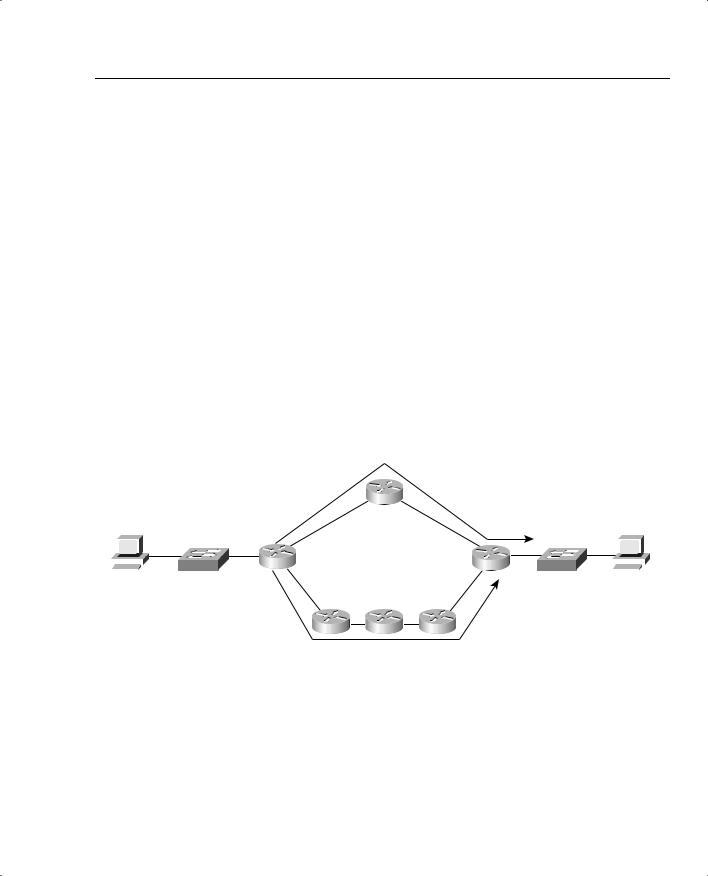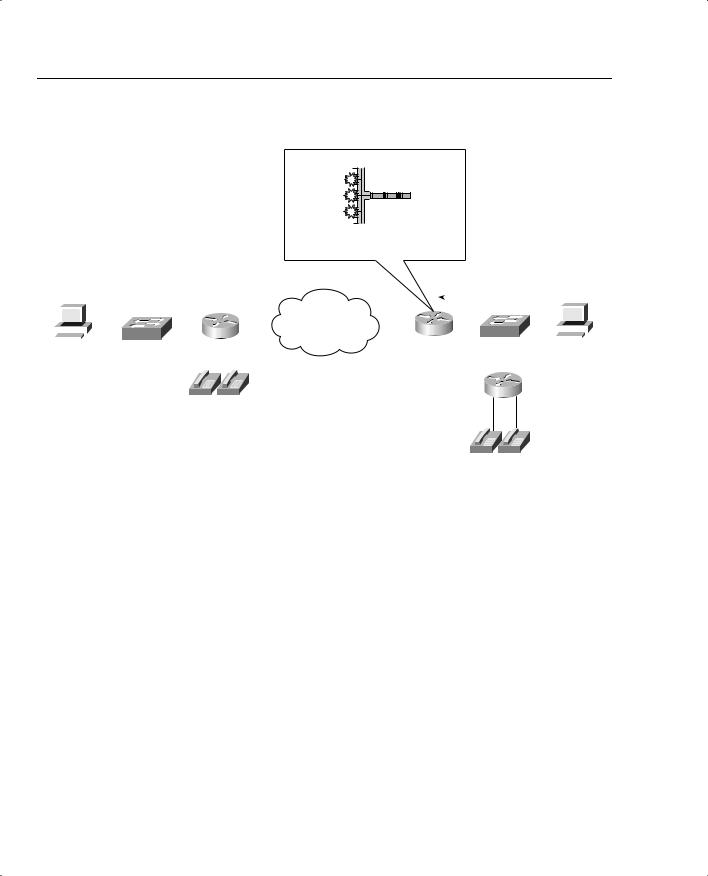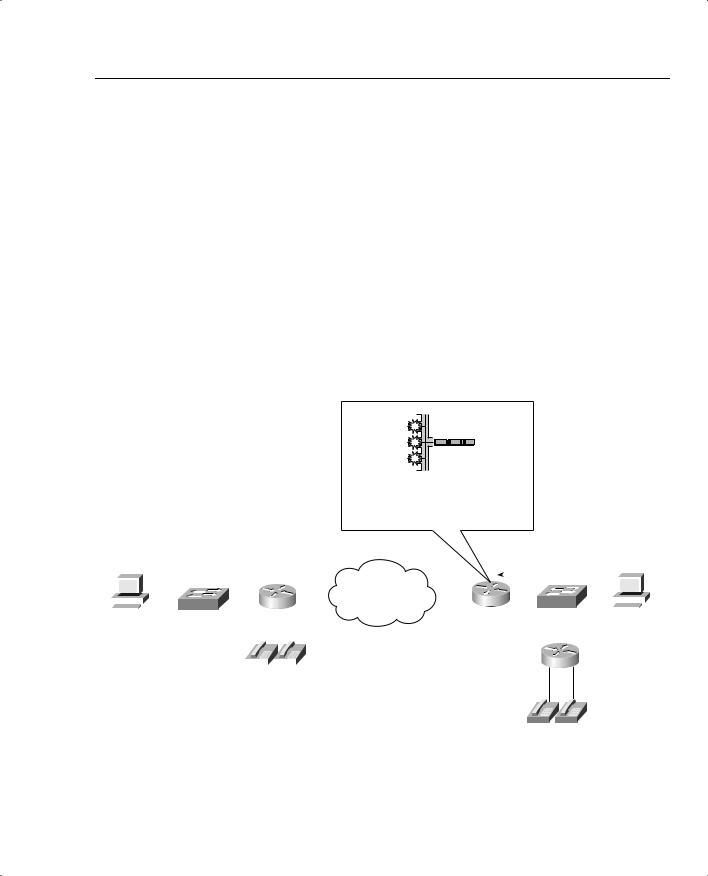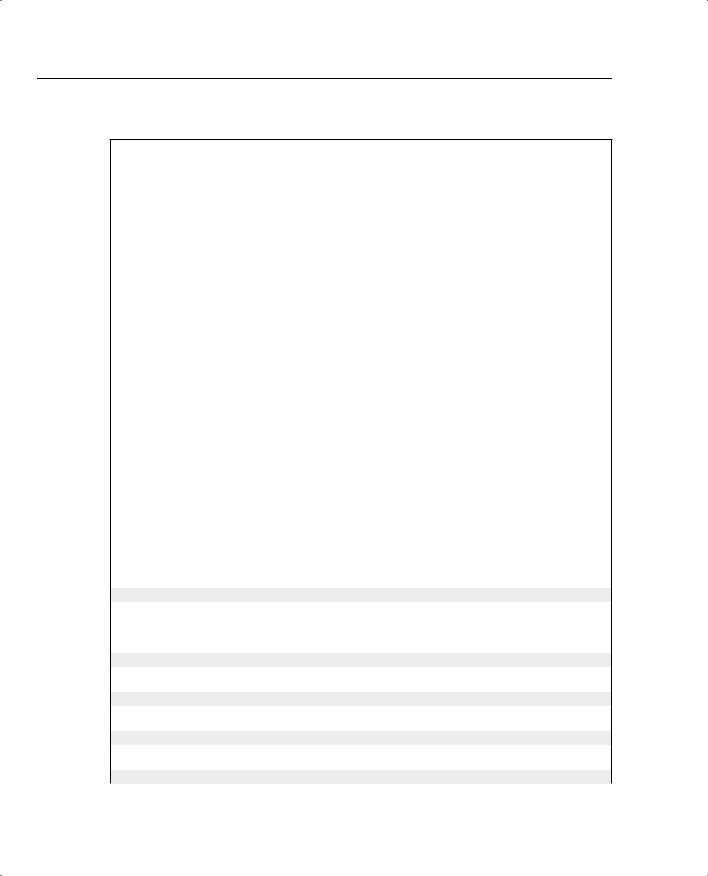
- •QoS Overview
- •“Do I Know This Already?” Quiz
- •QoS: Tuning Bandwidth, Delay, Jitter, and Loss Questions
- •Foundation Topics
- •QoS: Tuning Bandwidth, Delay, Jitter, and Loss
- •Bandwidth
- •The clock rate Command Versus the bandwidth Command
- •QoS Tools That Affect Bandwidth
- •Delay
- •Serialization Delay
- •Propagation Delay
- •Queuing Delay
- •Forwarding Delay
- •Shaping Delay
- •Network Delay
- •Delay Summary
- •QoS Tools That Affect Delay
- •Jitter
- •QoS Tools That Affect Jitter
- •Loss
- •QoS Tools That Affect Loss
- •Summary: QoS Characteristics: Bandwidth, Delay, Jitter, and Loss
- •Voice Basics
- •Voice Bandwidth Considerations
- •Voice Delay Considerations
- •Voice Jitter Considerations
- •Voice Loss Considerations
- •Video Basics
- •Video Bandwidth Considerations
- •Video Delay Considerations
- •Video Jitter Considerations
- •Video Loss Considerations
- •Comparing Voice and Video: Summary
- •IP Data Basics
- •Data Bandwidth Considerations
- •Data Delay Considerations
- •Data Jitter Considerations
- •Data Loss Considerations
- •Comparing Voice, Video, and Data: Summary
- •Foundation Summary
- •QoS Tools and Architectures
- •“Do I Know This Already?” Quiz
- •QoS Tools Questions
- •Differentiated Services Questions
- •Integrated Services Questions
- •Foundation Topics
- •Introduction to IOS QoS Tools
- •Queuing
- •Queuing Tools
- •Shaping and Policing
- •Shaping and Policing Tools
- •Congestion Avoidance
- •Congestion-Avoidance Tools
- •Call Admission Control and RSVP
- •CAC Tools
- •Management Tools
- •Summary
- •The Good-Old Common Sense QoS Model
- •GOCS Flow-Based QoS
- •GOCS Class-Based QoS
- •The Differentiated Services QoS Model
- •DiffServ Per-Hop Behaviors
- •The Class Selector PHB and DSCP Values
- •The Assured Forwarding PHB and DSCP Values
- •The Expedited Forwarding PHB and DSCP Values
- •The Integrated Services QoS Model
- •Foundation Summary
- •“Do I Know This Already?” Quiz Questions
- •CAR, PBR, and CB Marking Questions
- •Foundation Topics
- •Marking
- •IP Header QoS Fields: Precedence and DSCP
- •LAN Class of Service (CoS)
- •Other Marking Fields
- •Summary of Marking Fields
- •Class-Based Marking (CB Marking)
- •Network-Based Application Recognition (NBAR)
- •CB Marking show Commands
- •CB Marking Summary
- •Committed Access Rate (CAR)
- •CAR Marking Summary
- •Policy-Based Routing (PBR)
- •PBR Marking Summary
- •VoIP Dial Peer
- •VoIP Dial-Peer Summary
- •Foundation Summary
- •Congestion Management
- •“Do I Know This Already?” Quiz
- •Queuing Concepts Questions
- •WFQ and IP RTP Priority Questions
- •CBWFQ and LLQ Questions
- •Comparing Queuing Options Questions
- •Foundation Topics
- •Queuing Concepts
- •Output Queues, TX Rings, and TX Queues
- •Queuing on Interfaces Versus Subinterfaces and Virtual Circuits (VCs)
- •Summary of Queuing Concepts
- •Queuing Tools
- •FIFO Queuing
- •Priority Queuing
- •Custom Queuing
- •Weighted Fair Queuing (WFQ)
- •WFQ Scheduler: The Net Effect
- •WFQ Scheduling: The Process
- •WFQ Drop Policy, Number of Queues, and Queue Lengths
- •WFQ Summary
- •Class-Based WFQ (CBWFQ)
- •CBWFQ Summary
- •Low Latency Queuing (LLQ)
- •LLQ with More Than One Priority Queue
- •IP RTP Priority
- •Summary of Queuing Tool Features
- •Foundation Summary
- •Conceptual Questions
- •Priority Queuing and Custom Queuing
- •CBWFQ, LLQ, IP RTP Priority
- •Comparing Queuing Tool Options
- •“Do I Know This Already?” Quiz
- •Shaping and Policing Concepts Questions
- •Policing with CAR and CB Policer Questions
- •Shaping with FRTS, GTS, DTS, and CB Shaping
- •Foundation Topics
- •When and Where to Use Shaping and Policing
- •How Shaping Works
- •Where to Shape: Interfaces, Subinterfaces, and VCs
- •How Policing Works
- •CAR Internals
- •CB Policing Internals
- •Policing, but Not Discarding
- •Foundation Summary
- •Shaping and Policing Concepts
- •“Do I Know This Already?” Quiz
- •Congestion-Avoidance Concepts and RED Questions
- •WRED Questions
- •FRED Questions
- •Foundation Topics
- •TCP and UDP Reactions to Packet Loss
- •Tail Drop, Global Synchronization, and TCP Starvation
- •Random Early Detection (RED)
- •Weighted RED (WRED)
- •How WRED Weights Packets
- •WRED and Queuing
- •WRED Summary
- •Flow-Based WRED (FRED)
- •Foundation Summary
- •Congestion-Avoidance Concepts and Random Early Detection (RED)
- •Weighted RED (WRED)
- •Flow-Based WRED (FRED)
- •“Do I Know This Already?” Quiz
- •Compression Questions
- •Link Fragmentation and Interleave Questions
- •Foundation Topics
- •Payload and Header Compression
- •Payload Compression
- •Header Compression
- •Link Fragmentation and Interleaving
- •Multilink PPP LFI
- •Maximum Serialization Delay and Optimum Fragment Sizes
- •Frame Relay LFI Using FRF.12
- •Choosing Fragment Sizes for Frame Relay
- •Fragmentation with More Than One VC on a Single Access Link
- •FRF.11-C and FRF.12 Comparison
- •Foundation Summary
- •Compression Tools
- •LFI Tools
- •“Do I Know This Already?” Quiz
- •Foundation Topics
- •Call Admission Control Overview
- •Call Rerouting Alternatives
- •Bandwidth Engineering
- •CAC Mechanisms
- •CAC Mechanism Evaluation Criteria
- •Local Voice CAC
- •Physical DS0 Limitation
- •Max-Connections
- •Voice over Frame Relay—Voice Bandwidth
- •Trunk Conditioning
- •Local Voice Busyout
- •Measurement-Based Voice CAC
- •Service Assurance Agents
- •SAA Probes Versus Pings
- •SAA Service
- •Calculated Planning Impairment Factor
- •Advanced Voice Busyout
- •PSTN Fallback
- •SAA Probes Used for PSTN Fallback
- •IP Destination Caching
- •SAA Probe Format
- •PSTN Fallback Scalability
- •PSTN Fallback Summary
- •Resource-Based CAC
- •Resource Availability Indication
- •Gateway Calculation of Resources
- •RAI in Service Provider Networks
- •RAI in Enterprise Networks
- •RAI Operation
- •RAI Platform Support
- •Cisco CallManager Resource-Based CAC
- •Location-Based CAC Operation
- •Locations and Regions
- •Calculation of Resources
- •Automatic Alternate Routing
- •Location-Based CAC Summary
- •Gatekeeper Zone Bandwidth
- •Gatekeeper Zone Bandwidth Operation
- •Single-Zone Topology
- •Multizone Topology
- •Zone-per-Gateway Design
- •Gatekeeper in CallManager Networks
- •Zone Bandwidth Calculation
- •Gatekeeper Zone Bandwidth Summary
- •Integrated Services / Resource Reservation Protocol
- •RSVP Levels of Service
- •RSVP Operation
- •RSVP/H.323 Synchronization
- •Bandwidth per Codec
- •Subnet Bandwidth Management
- •Monitoring and Troubleshooting RSVP
- •RSVP CAC Summary
- •Foundation Summary
- •Call Admission Control Concepts
- •Local-Based CAC
- •Measurement-Based CAC
- •Resources-Based CAC
- •“Do I Know This Already?” Quiz
- •QoS Management Tools Questions
- •QoS Design Questions
- •Foundation Topics
- •QoS Management Tools
- •QoS Device Manager
- •QoS Policy Manager
- •Service Assurance Agent
- •Internetwork Performance Monitor
- •Service Management Solution
- •QoS Management Tool Summary
- •QoS Design for the Cisco QoS Exams
- •Four-Step QoS Design Process
- •Step 1: Determine Customer Priorities/QoS Policy
- •Step 2: Characterize the Network
- •Step 3: Implement the Policy
- •Step 4: Monitor the Network
- •QoS Design Guidelines for Voice and Video
- •Voice and Video: Bandwidth, Delay, Jitter, and Loss Requirements
- •Voice and Video QoS Design Recommendations
- •Foundation Summary
- •QoS Management
- •QoS Design
- •“Do I Know This Already?” Quiz
- •Foundation Topics
- •The Need for QoS on the LAN
- •Layer 2 Queues
- •Drop Thresholds
- •Trust Boundries
- •Cisco Catalyst Switch QoS Features
- •Catalyst 6500 QoS Features
- •Supervisor and Switching Engine
- •Policy Feature Card
- •Ethernet Interfaces
- •QoS Flow on the Catalyst 6500
- •Ingress Queue Scheduling
- •Layer 2 Switching Engine QoS Frame Flow
- •Layer 3 Switching Engine QoS Packet Flow
- •Egress Queue Scheduling
- •Catalyst 6500 QoS Summary
- •Cisco Catalyst 4500/4000 QoS Features
- •Supervisor Engine I and II
- •Supervisor Engine III and IV
- •Cisco Catalyst 3550 QoS Features
- •Cisco Catalyst 3524 QoS Features
- •CoS-to-Egress Queue Mapping for the Catalyst OS Switch
- •Layer-2-to-Layer 3 Mapping
- •Connecting a Catalyst OS Switch to WAN Segments
- •Displaying QoS Settings for the Catalyst OS Switch
- •Enabling QoS for the Catalyst IOS Switch
- •Enabling Priority Queuing for the Catalyst IOS Switch
- •CoS-to-Egress Queue Mapping for the Catalyst IOS Switch
- •Layer 2-to-Layer 3 Mapping
- •Connecting a Catalyst IOS Switch to Distribution Switches or WAN Segments
- •Displaying QoS Settings for the Catalyst IOS Switch
- •Foundation Summary
- •LAN QoS Concepts
- •Catalyst 6500 Series of Switches
- •Catalyst 4500/4000 Series of Switches
- •Catalyst 3550/3524 Series of Switches
- •QoS: Tuning Bandwidth, Delay, Jitter, and Loss
- •QoS Tools
- •Differentiated Services
- •Integrated Services
- •CAR, PBR, and CB Marking
- •Queuing Concepts
- •WFQ and IP RTP Priority
- •CBWFQ and LLQ
- •Comparing Queuing Options
- •Conceptual Questions
- •Priority Queuing and Custom Queuing
- •CBWFQ, LLQ, IP RTP Priority
- •Comparing Queuing Tool Options
- •Shaping and Policing Concepts
- •Policing with CAR and CB Policer
- •Shaping with FRTS, GTS, DTS, and CB Shaping
- •Shaping and Policing Concepts
- •Congestion-Avoidance Concepts and RED
- •WRED
- •FRED
- •Congestion-Avoidance Concepts and Random Early Detection (RED)
- •Weighted RED (WRED)
- •Flow-Based WRED (FRED)
- •Compression
- •Link Fragmentation and Interleave
- •Compression Tools
- •LFI Tools
- •Call Admission Control Concepts
- •Local-Based CAC
- •Measurement-Based CAC
- •Resources-Based CAC
- •QoS Management Tools
- •QoS Design
- •QoS Management
- •QoS Design
- •LAN QoS Concepts
- •Catalyst 6500 Series of Switches
- •Catalyst 4500/4000 Series of Switches
- •Catalyst 3550/3524 Series of Switches
- •Foundation Topics
- •QPPB Route Marking: Step 1
- •QPPB Per-Packet Marking: Step 2
- •QPPB: The Hidden Details
- •QPPB Summary
- •Flow-Based dWFQ
- •ToS-Based dWFQ
- •Distributed QoS Group–Based WFQ
- •Summary: dWFQ Options

Classification and Marking Tools 201
based on the contents of packet headers and marks QoS fields based on those classifications. Dial peers provide very different classification options, so fewer direct comparisons can be drawn.
Refer to Table 3-17 for a complete list of classification and marking fields used by CAR.
Policy-Based Routing (PBR)
PBR enables you to route a packet based on other information, in addition to the destination IP address. In most cases, engineers are happy with the choices of routes made by the routing protocol, with routing occurring based on the destination IP address in each packet. For some specialized cases, however, an engineer may want some packets to take a different path. One path through the network may be more secure, for instance, so some packets could be directed through a longer, but more secure, path. Some packets that can tolerate high latency may be routed through a path that uses satellite links, saving bandwidth on the lower-latency terrestrial circuits for delay-sensitive traffic. Regardless of the reasons, PBR can classify packets and choose a different route. Figure 3-17 shows a simple example, where FTP traffic is directed over the longer path in the network.
Figure 3-17 PBR: FTP Traffic Routed over Longer Path
|
|
|
|
|
|
|
Routing Tables’ route |
|
|
|
|
|
|
|
|
|
|
|
|
|
|
|
R2 |
|
|
|
|
|
|
|
|
Client1 |
|
|
|
|
Server1 |
||||||||||
|
|
|
|
|
SW1 |
R1 |
R3 |
SW2 |
|
|
|
|
|
|
|
|
|
|
|
|
|
|
|
|
|
|
|
||||
|
|
|
|
|
|
|
|
|
|
|
|
||||
|
|
|
|
|
|
|
|
|
|
|
|
||||
R4 R5 R6
FTP Sent This Way Using PBR
PBR supports packet marking and policy routing. As you learned in previous sections, CAR supports marking because CAR’s main feature, policing, benefits from having the marking feature available as well. Similarly, PBR includes a marking feature, because in some cases, PBR is used to pick a different route for QoS reasons—for instance, to affect the latency of a packet. So, PBR’s core function can benefit from marking a packet, so that the appropriate QoS action can be taken as the packet traverses the network. Just as with CAR, you can use PBR’s marking feature without actually using its core feature. In other words, you can use PBR just

202 Chapter 3: Classification and Marking
for classification and marking, without choosing a different route. The examples in this chapter focus only on PBR as a marking tool.
Unlike CB marking and CAR, PBR only processes packets entering an interface; you cannot enable it for packets exiting an interface. The reason PBR only processes incoming packets relates to its core function: policy routing. PBR needs to process packets before a routing decision has been made. Therefore, PBR processes packets entering an interface, preempting the normal routing logic based on destination IP address.
Finally, one other difference between PBR and the other classification and marking tools covered so far (CB marking and CAR) is that PBR can classify based on routing information, instead of totally relying on information in the frame or packet header. PBR can look up the entry in the routing table that matches a packet’s destination address, for instance, and then classify based on information about that route. For example, the metric associated with that route, the source of the routing information, or the next-hop interface associated with the route can be checked. In most cases, this routing information does not help you with differentiating between different types of traffic. An FTP server, an IP Phone, a video server, and some web servers may all be in the same subnet, for instance, but the routing information about that subnet could not help PBR distinguish between those different types of traffic. Therefore, typically the most useful classification feature of PBR, when used for marking, is just to refer to an IP ACL.
PBR configuration uses yet another totally different set of configuration commands as compared to CB marking and CAR. PBR does separate the classification, marking, and enabling features into different commands. Tables 3-14 and 3-15 list the pertinent PBR configuration and exec commands, respectively. Following the tables, two example PBR configurations are shown. The two examples use the same criteria as the two CAR samples.
Table 3-14 Configuration Command Reference for PBR
Command |
Mode and Function |
|
|
ip local policy route-map map-tag |
Global; specifies that packets generated by this |
|
router should be candidates for policy routing |
|
|
ip policy route-map map-tag |
Interface subcommand; refers to a route map, |
|
which in turn classifies packets and specifies |
|
actions; actions include specifying a different |
|
route, and setting IP precedence |
|
|
route-map map-tag [permit | deny] [sequence- |
Global command; creates a route map entry |
number] |
|
|
|
match ip address {access-list-number | access- |
Route-map subcommand; used to match IP |
list-name} [... access-list-number | ... access-list- |
packets based on parameters that can be matched |
name] |
with an IP ACL |
|
|
match length minimum-length maximum-length |
Route-map subcommand; used to match IP |
|
packets based on their length |
|
|

Classification and Marking Tools 203
Table 3-14 Configuration Command Reference for PBR (Continued)
|
Command |
|
Mode and Function |
|
|
|
|
|
set ip precedence number | name |
Route-map subcommand; sets IP precedence |
|
|
|
|
value using the decimal number of name |
|
|
|
|
|
set ip next-hop ip-address [...ip-address] |
Route-map subcommand; defines the IP |
|
|
|
|
address(es) of the next-hop router(s) to be used |
|
|
|
for forwarding packets that match this route map |
|
|
|
entry |
|
|
|
|
|
ip route-cache policy |
|
Global command; enables fast switching of PBR- |
|
|
|
routed packets |
|
|
|
|
|
Note: Not all PBR-related commands are shown in this table, but commands specifically related to marking are |
||
|
shown. |
|
|
Table 3-15 Exec Command Reference for PBR Marking |
|
||
|
|
|
|
|
Command |
Function |
|
|
|
|
|
|
show ip policy |
Lists configured PBR details, and statistics for numbers of packets |
|
|
|
matched by each clause. |
|
|
|
|
|
|
show route-map |
Lists statistical information about packets matched with a route map. |
|
|
|
PBR uses route maps to classify and mark traffic. |
|
|
|
|
|
Example 3-7 shows the first PBR marking example, which uses the same criteria as Example 3-1 for CB marking and Example 3-5 for CAR. In this example, R3 is marking packets that flow right to left in Figure 3-18.
•
•
All VoIP payload traffic is marked with IP precedence 5.
All other traffic is marked with IP precedence 0.
Example 3-7 PBR Marking, VoIP as DSCP EF, Everything Else as BE
ip route-cache policy
!
ip access-list extended VoIP-ACL
permit udp any range 16384 32767 any range 16384 32767
!
int fastethernet 0/0
ip policy route-map voip-routemap
!
route-map voip-routemap permit 10 match ip address VoIP-ACL
set ip precedence 5
!
route-map voip-routemap permit 20 set ip precedence 0

204 Chapter 3: Classification and Marking
Figure 3-18 PBR Marking Sample 1: VoIP Marked with IP Precedence 5, Everything Else Marked IP Precedence 0
Mark
X |
Y |
Z |
Mark VoIP with IP Precedence 5
Mark All Else with IP Precedence 0
Note: All IP Addresses Begin 192.168.
|
|
|
|
|
|
|
|
|
|
|
|
|
|
Packet Direction |
|||||||
Client1 |
|
|
|
|
|
|
|
|
|
Server1 |
|||||||||||
2.252 |
2.253 |
3.253 |
|
||||||||||||||||||
|
|
|
|
|
|
|
|
|
|||||||||||||
|
|
1.252 |
|
|
|
|
|
|
|
|
|||||||||||
|
|
|
|
|
|
|
|
|
|
|
|
|
|
|
|
|
|
|
|
|
|
|
|
|
|
|
SW1 |
R1 |
|
s0/0 |
s0/0 |
R3 FA0/0 SW2 |
|
|
|
|
|
||||||
|
|
|
|
|
|
|
|
|
|
||||||||||||
1.1 |
|
|
|
|
|
|
|
|
|
|
|
|
|
|
3.100 |
|
|
||||
|
|
|
|
|
|
|
|
|
|
|
|
|
|
|
|
3.254 |
|
|
|
|
|
|
|
|
|
|
|
|
|
|
|
|
|
|
|
|
|
|
|
|
|
|
|
|
|
|
|
|
|
|
|
|
|
|
|
|
|
|
|
|
|
|
|
|
|
|
|
|
|
|
|
|
|
|
|
|
|
|
|
|
|
|
|
|
|
|
|
R4
1001 1002
3001 3002
PBR uses route-map commands, along with match and set route-map subcommands, to classify and mark the packets. This configuration uses a route map named voip-routemap, which includes two clauses. The first clause, clause 10, uses a match command that refers to VoIP-ACL, which is a named IP ACL. VoIP-ACL matches UDP port numbers between 16,384 and 32,767, which matches all VoIP traffic. If the ACL permits a packet, the route map’s first clause acts on the set command, which specifies that IP precedence should be set to 5.
The second route map clause, clause 20, matches the rest of the traffic. The route map could have referred to another IP ACL to match all packets; however, by not specifying a match statement in clause 20, all packets will match this clause by default. By not having to refer to another IP ACL to match all packets, less processing overhead is required. The set command then specifies to set precedence to zero.
The ip policy route-map voip-routemap command enables PBR on interface FA0/0 for incoming packets. Notice that the direction, input or output, is not specified, because PBR can only process incoming packets.

Classification and Marking Tools 205
The last PBR-specific command is ip route-cache policy. IOS process-switches PBR traffic by default; to use fast switching on PBR traffic, use the ip route-cache policy command.
The second PBR configuration (Example 3-8) includes classification options identical to CAR example 2 (see Example 3-6). A major difference between PBR and CAR is that PBR cannot set the DSCP field, so it sets the IP Precedence field instead. The slightly modified criteria, as compared with CAR example 2, for PBR example 2 is as follows:
•VoIP payload is marked with precedence 5.
•NetMeeting voice and video from Server1 to Client1 is marked with precedence 4.
•Any HTTP traffic is marked with precedence 2.
•All other traffic is marked with precedence 0.
Figure 3-19 shows the network in which the configuration is applied, and Example 3-8 shows the configuration.
Figure 3-19 PBR Marking Sample 2 Network
Mark
X |
Y |
Z |
Mark VoIP as IP Precedence 5
Mark NetMeeting as IP Precedence 4
Mark HTTP as IP Precedence 2
Mark All Else as IP Precedence 0
Client1 |
|
|
|
|
|
Packet Direction |
Server1 |
||||||||||||||
|
|
|
|
|
|
|
|
|
|
|
|
|
|
|
|
|
|
|
|
|
|
|
|
|
|
|
|
|
|
|
|
|
|
|
|
|
|
|
|
|
|
|
|
|
|
|
|
|
SW1 |
R1 |
|
s0/0 |
s0/0 R3 FA0/0 SW2 |
|
|
|
|
|
|
||||||
|
|
|
|
|
|
|
|
|
|
|
|||||||||||
|
|
|
|
|
|
|
|
|
|
|
|
|
|
|
|
|
|
|
|
|
|
|
|
|
|
|
|
|
|
|
|
|
|
|
|
|
|
|
|
|
|
|
|
|
|
|
|
|
|
|
|
|
|
|
|
|
|
|
|
|
|
|
|
|
|

 R4 1001 1002
R4 1001 1002
3001 3002

206 Chapter 3: Classification and Marking
Example 3-8 PBR Marking Sample 2: VoIP, NetMeeting Audio/Video, HTTP URLs, and Everything Else
ip route-cache policy
!
ip access-list extended VoIP-ACL
permit udp any range 16384 32768 any range 16384 32768
!
ip access-list extended NetMeet-ACL
permit udp host 192.168.1.100 range 16384 32768 192.168.3.0 0.0.0.255 range 16384 32768
!
!
ip access-list extended http-acl permit tcp any eq www any permit tcp any any eq www
!
interface fastethernet 0/0
ip policy route-map voip-routemap
!
route-map voip-routemap permit 10 match ip-address NetMeet-ACL
set ip precedence 4
!
route-map voip-routemap permit 20 match ip-address VoIP-ACL
set ip precedence 5
!
route-map voip-routemap permit 30 match ip-address http-acl
set ip precedence 2
!
route-map voip-routemap permit 40 set ip precedence 0
! |
|
end |
|
R3#sh ip policy |
|
Interface |
Route map |
Fastethernet0/0 |
voip-routemap |
R3#show route-map
route-map voip-routemap, permit, sequence 10 Match clauses:
ip address (access-lists): NetMeet-ACL Set clauses:
ip precedence flash-override
Policy routing matches: 3 packets, 222 bytes route-map voip-routemap, permit, sequence 20
Match clauses:
ip address (access-lists): VoIP-ACL Set clauses:
ip precedence critical
Policy routing matches: 14501 packets, 1080266 bytes
